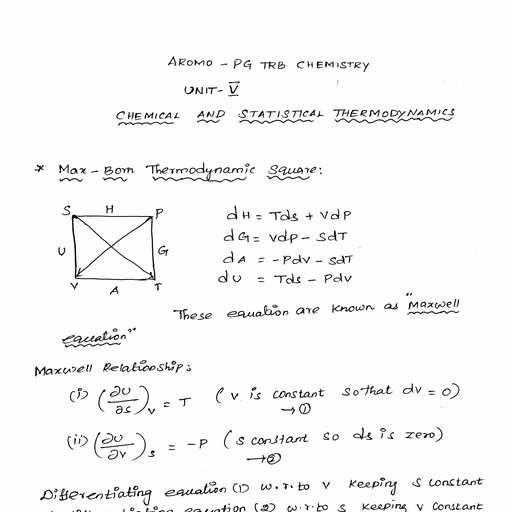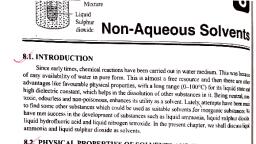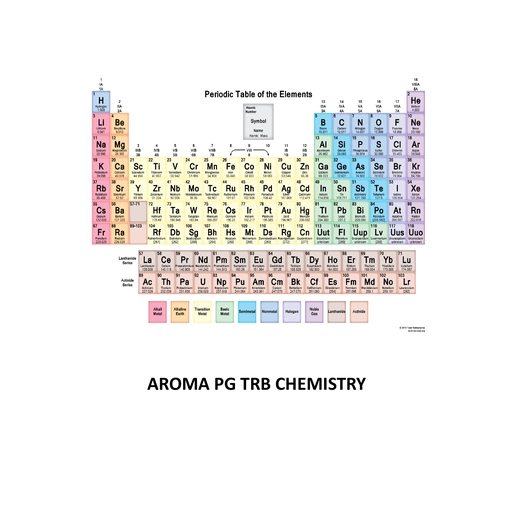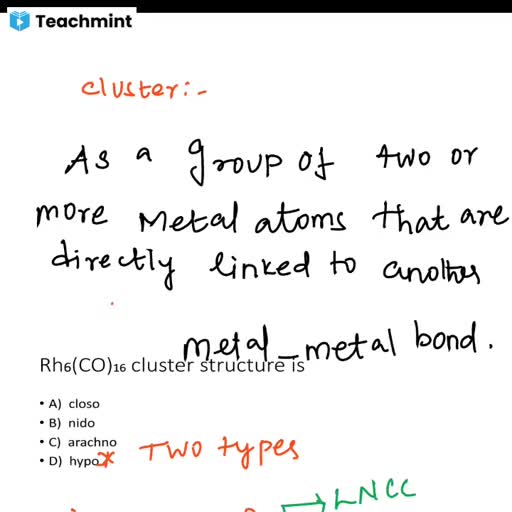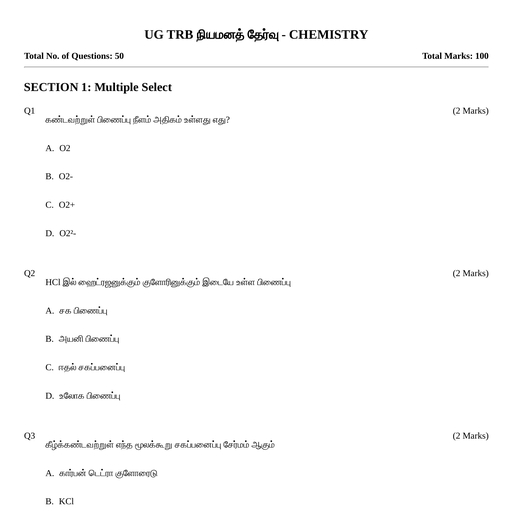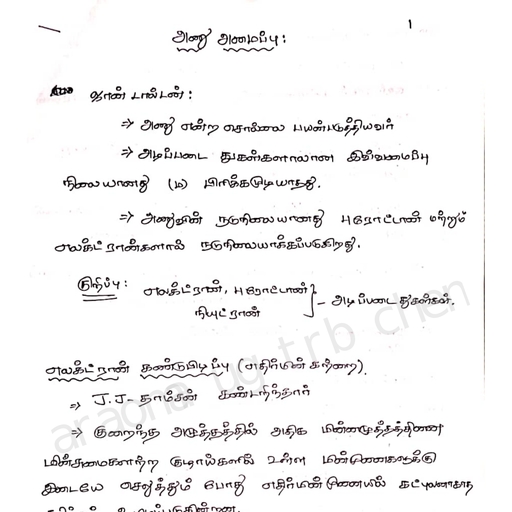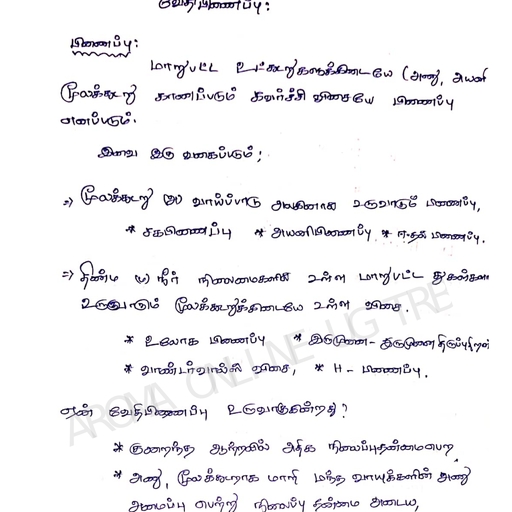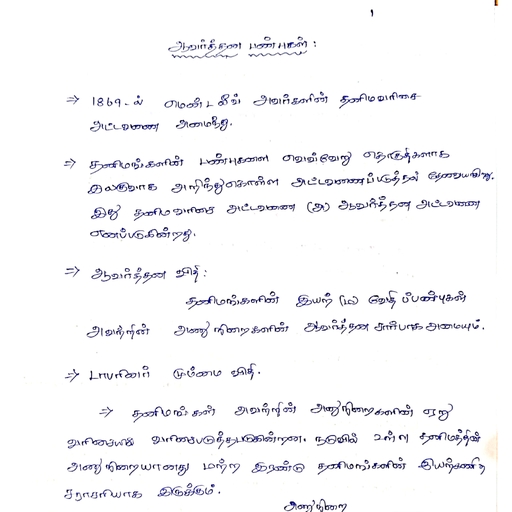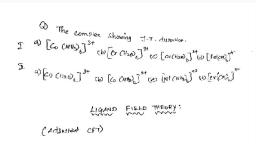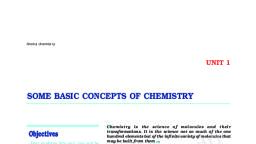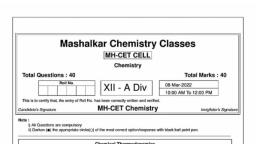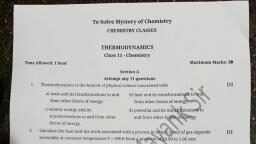Question 3 :
At absolute zero, the entropy of a perfect crystal is zero. This is of thermodynamics.
Question 4 :
One mole of a non-ideal gas undergoes a change of state {tex} ( 2.0 \text { atm, } 3.0 \mathrm { L } , 95 \mathrm { K } ) \rightarrow ( 4.0 \mathrm { atm } , {/tex} {tex} 5.0 \mathrm { L } , 245 \mathrm { K } ) {/tex} with a change in internal energy, {tex} \Delta \mathrm { U } = 30.0 \mathrm { L } \mathrm { atm } . {/tex} The change in enthalpy {tex} \Delta \mathrm { H } {/tex} of the process in {tex} \mathrm { L } {/tex} atm is.
Question 5 :
A person requires 2870 kcal of energy to lead normal daily life. If heat of combustion of cane sugar is <img style='object-fit:contain' src="https://storage.googleapis.com/teachmint/question_assets/NEET/5ea7d2acc2a2ae2953d94827"> kcal, then his daily consumption of sugar is:
Question 7 :
The standard enthalpy of formation (DHf°) at 398 K for methane, CH<sub>4</sub>(g) is 74.8 kJ mol<sup>–1</sup>. The
additional information required to determine the average energy for C – H bond formation would
be.
Question 10 :
At constant pressure and temperature, the direction of any chemical reaction is one where, the decrease.
Question 11 :
Enthalpy of neutralisation of {tex} \mathrm {HCl}{/tex} with {tex} \mathrm { NaOH }{/tex} is {tex}x{/tex}. The heat evolved when {tex} 500 \mathrm { mL } {/tex} of {tex} 2 \mathrm { NCl } {/tex} are mixed with {tex}250 \mathrm { mL } {/tex} of {tex} 4 \ \mathrm { {N} \ \mathrm { NaOH }}{/tex} will be.
Question 12 :
All the naturally occurring processes, <img style='object-fit:contain' src="https://storage.googleapis.com/teachmint/question_assets/NEET/5ea7d29fab3481716f4b76e7"> spontaneous proceed spontaneously in a direction which leads to:
Question 13 :
The enthalpy of vapourisation of water from the following two equations is.<br>{tex} \mathrm { H } _ { 2 } ( \mathrm { g } ) + \frac { 1 } { 2 } \mathrm { O } _ { 2 } ( \mathrm { g } ) \longrightarrow \mathrm { H } _ { 2 } \mathrm { O } ( \mathrm { l } ) , \Delta \mathrm { H } = - 286 \mathrm { kJ } {/tex}<br>{tex} \mathrm { H } _ { 2 } ( \mathrm { g } ) + \frac { 1 } { 2 } \mathrm { O } _ { 2 } ( \mathrm { g } ) , \rightarrow \mathrm { H } _ { 2 } \mathrm { O } ( \mathrm { g } ) , \Delta \mathrm { H } = - 245.5 \mathrm { kJ } {/tex}
Question 14 :
What is the entropy change (in {tex} \mathrm { JK } ^ { - 1 } \mathrm { mol } ^ { - 1 } {/tex} ) when one mole of ice is converted into water at {tex} 0 ^ { \circ } \mathrm { C } {/tex} ? (The enthalpy change for the conversion of ice to liquid water is {tex} 6.0 \mathrm { kJ } \mathrm { mol } ^ { - 1 } {/tex} at {tex} 0 ^ { \circ } \mathrm { C } {/tex} )
Question 15 :
Under the same conditions how many mL of <img style='object-fit:contain' src="https://storage.googleapis.com/teachmint/question_assets/NEET/5ea7d13ac2a2ae2953d94643"> and <img style='object-fit:contain' src="https://storage.googleapis.com/teachmint/question_assets/NEET/5ea7d13a6f3020298ca13af1"> solutions, respectively when mixed for a total volume of 100 mL produce the highest rise in temperature?
Question 16 :
The enthalpy of vaporisation of a substance is <b>840 J/mol</b> and its boiling point is <b>-173°C</b> . Its entropy of vaporisation is
Question 18 :
The heats of neutralisation of {tex} \mathrm { CH } _ { 3 } \mathrm { COOH } {/tex}, {tex} \mathrm { HCOOH } , \mathrm { HCN } {/tex} and {tex} \mathrm { H } _ { 2 } \mathrm { S } {/tex} are {tex} - 13.2 , - 13.4 , - 2.9 {/tex} and {tex} - 3.8 \mathrm { kcal } {/tex} per equivalent respectively. Arrange the acids in increasing order of strength
Question 19 :
The work done in ergs for the reversible expansion of one mole of an ideal gas from a volume of 10 litres to 20 litres at is
Question 20 :
A container has hydrogen and oxygen mixture in ratio of <img style='object-fit:contain' src="https://storage.googleapis.com/teachmint/question_assets/NEET/5ea7d1b56f3020298ca13bf2"> by weight, then:
Question 21 :
When a gas undergoes adiabatic expansion, it gets cooled due to
Question 23 :
The exchange of heat energy during chemical reaction at constant temperature and pressure occurs in form of:
Question 26 :
The latent heat of vapourization of a liquid at {tex} 500 \mathrm { K } {/tex} and {tex}1{/tex} atm pressure is {tex} 10.0 \mathrm { kcal } / \mathrm { mol } {/tex}. What will be the change in internal energy {tex} ( \Delta \mathrm { U } ) {/tex} of {tex}3{/tex} moles of liquid at the same temperature
Question 27 :
The heat of neutralisation of a strong acid and a strong alkali is 5 <img style='object-fit:contain' src="https://storage.googleapis.com/teachmint/question_assets/NEET/5ea7d2b5c2a2ae2953d94840"> . The heat released when 0.5 mole of <img style='object-fit:contain' src="https://storage.googleapis.com/teachmint/question_assets/NEET/5ea7d1db399925718ac6afe8"> solution is mixed with 0.2 mole of KOH is
Question 29 :
The enthalpies of the elements in their standard states are assumed to be
Question 30 :
48 g of C (diamond) on complete combustion evolves 1584 kJ of heat. The standard heat of formation of gaseous carbon is 725 kJ/mol. The energies required for the process<br> (i)C (graphite) <img style='object-fit:contain' src="https://storage.googleapis.com/teachmint/question_assets/NEET/5ea7d1746f3020298ca13b95"> C(gas)<br> (ii)C (diamond) <img style='object-fit:contain' src="https://storage.googleapis.com/teachmint/question_assets/NEET/5ea7d1746f3020298ca13b95"> C(gas)are:
Question 31 :
An ideal gas expands against a constant external pressure of {tex}2.0{/tex} atmosphere from {tex}20{/tex} litre to {tex}40{/tex} litre and absorbs {tex} 10 \mathrm { kJ } {/tex} of heat from surrounding. What is the change in internal energy of the system? (given : {tex} \text { latm-litre } = 101.3 \mathrm { J } ) {/tex}
Question 32 :
One mole of solid iron was vaporized in an oven at its boiling point of {tex} 3433 \mathrm { K } {/tex} and enthalpy of vaporization of iron is {tex} 344.3 \mathrm { kJ } \mathrm { mol } ^ { - 1 } . {/tex} The value of entropy vaporization (in {tex} \left. \mathrm { J } \mathrm { mol } ^ { - 1 } \right) {/tex} of iron is
Question 35 :
What is the free energy change for the conversion of {tex}1{/tex} mole of water into steam at {tex} 373.2 \mathrm { K } {/tex}.
The heat of vaporization {tex} \left( \Delta \mathrm { H } _ { \mathrm { v } } \right) {/tex} of water of {tex} 373.2 \mathrm { K } {/tex} is {tex} 9.1 \mathrm { kcal } \mathrm { mol } ^ { - 1 } . {/tex} The entropy change is {tex} 25.5 \mathrm { cal } / \mathrm { mol } {/tex} deg.
Question 36 :
A well stoppered thermos flask containing some ice cubes is an example of:
Question 39 :
Which of the following statements is true?
The entropy of the universe
Question 40 :
Standard enthalpy of vapourisation {tex}\mathrm {\Delta_{vap} H^\circ}{/tex} for water at {tex}100^\circ{/tex} is {tex}\mathrm {40.66\ kJ\ mol^{-1}}{/tex}. The internal energy of vapourisation of water at {tex}100^\circ{/tex} C (in {tex}\mathrm {kJ\ mol^{-1}}{/tex}) is
Question 41 :
A given mass of gas expands reversibly from the state {tex}A{/tex} to the state {tex}B{/tex} by three paths {tex}1 , 2{/tex} and {tex}3{/tex} as shown in the figure. If {tex}w_1 , w_ 2{/tex} and {tex}w_3{/tex} respectively be the work done by the gas along three paths then:<br> <img style='object-fit:contain' src='https://storage.googleapis.com/teachmint/question_assets/NEET/5efadb7a2cb6ea3d580629d4' class="uploaded-image" />
Question 44 :
The {tex} \mathrm { (S°) } {/tex}of the following substances are: <br>{tex} \mathrm {CH_4(g)} {/tex} {tex}186.2 \mathrm {Jk^{-1}mol^{-1}}{/tex}<br>{tex} \mathrm {O_2(g)} {/tex} {tex}205.2 \mathrm {Jk^{-1}mol^{-1}}{/tex}<br> {tex} \mathrm {CO_2(g)} {/tex} {tex}213.6 \mathrm {Jk^{-1}mol^{-1}}{/tex}<br> {tex} \mathrm {H_2O(g)} {/tex} {tex}69.9 \mathrm {Jk^{-1}mol^{-1}}{/tex}<br> The entropy change {tex} \mathrm {\Delta S}^ {\circ}{/tex} for the reaction {tex}\mathrm { CH_4 (g) + 2O_2(g) \rightarrow CO_2 (g)+ 2H_2O(l)}{/tex}is
Question 48 :
A closed flask contains water in all its three states, solids, liquid and vapour at <img style='object-fit:contain' src="https://storage.googleapis.com/teachmint/question_assets/NEET/5ea7d1cd399925718ac6afbd"> In this situation the average KE of the water molecule will be:
Question 49 :
It is impossible to attain the lowest temperature known as zero degree absolute. This is a simple statement of:
